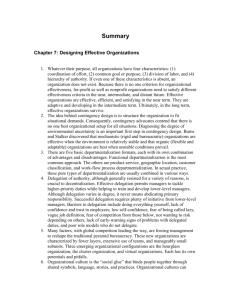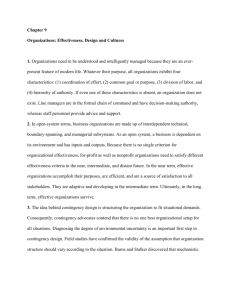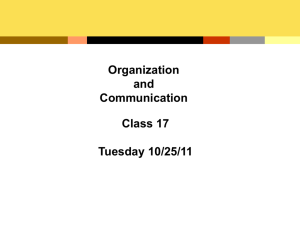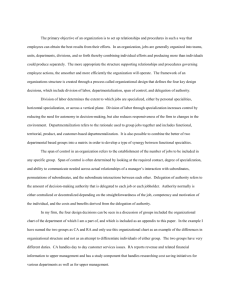Job Design
advertisement
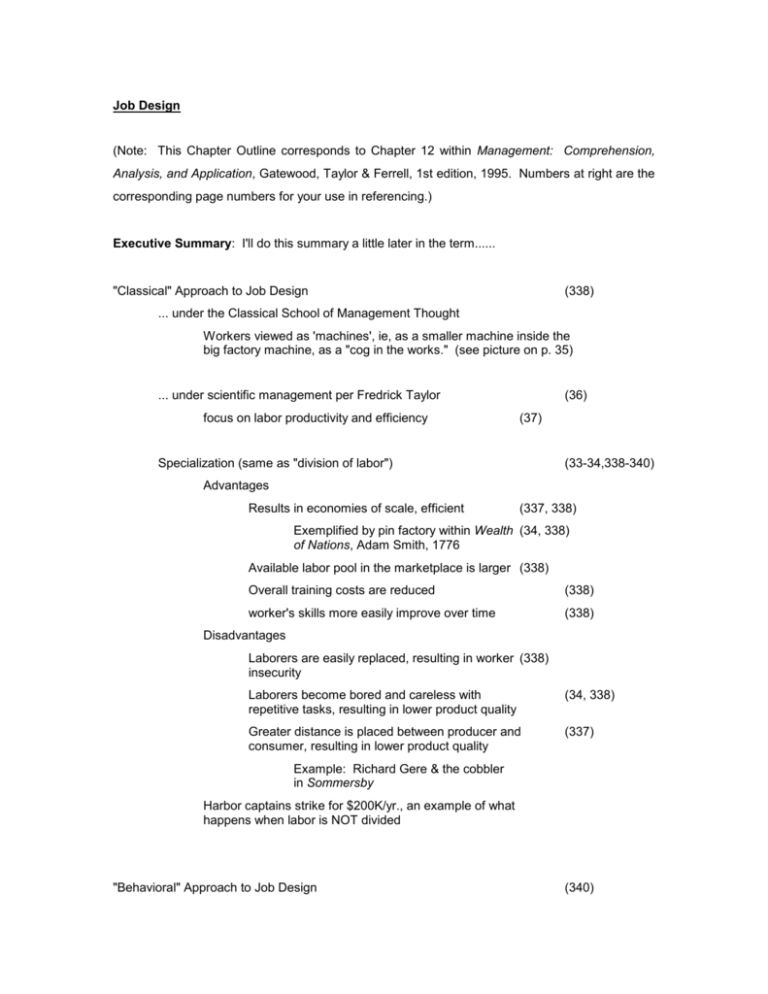
Job Design (Note: This Chapter Outline corresponds to Chapter 12 within Management: Comprehension, Analysis, and Application, Gatewood, Taylor & Ferrell, 1st edition, 1995. Numbers at right are the corresponding page numbers for your use in referencing.) Executive Summary: I'll do this summary a little later in the term...... "Classical" Approach to Job Design (338) ... under the Classical School of Management Thought Workers viewed as 'machines', ie, as a smaller machine inside the big factory machine, as a "cog in the works." (see picture on p. 35) ... under scientific management per Fredrick Taylor focus on labor productivity and efficiency (36) (37) Specialization (same as "division of labor") (33-34,338-340) Advantages Results in economies of scale, efficient (337, 338) Exemplified by pin factory within Wealth (34, 338) of Nations, Adam Smith, 1776 Available labor pool in the marketplace is larger (338) Overall training costs are reduced (338) worker's skills more easily improve over time (338) Disadvantages Laborers are easily replaced, resulting in worker (338) insecurity Laborers become bored and careless with repetitive tasks, resulting in lower product quality (34, 338) Greater distance is placed between producer and consumer, resulting in lower product quality (337) Example: Richard Gere & the cobbler in Sommersby Harbor captains strike for $200K/yr., an example of what happens when labor is NOT divided "Behavioral" Approach to Job Design (340) MAN 351 / Polito 0351967413 Views workers as 'people' and embraces the use of sociological & psychological techniques Exam 3 (43) Advocates Job enlargement (340) Increasing the number of tasks incorporated within a particular job Intended to defeat boredom of "classical" jobs Job rotation (340) (341) Moving workers "from job to job" on a regular basis Intended to defeat boredom of "classical" jobs (341) Aids workers in understanding how "other parts of the organization work, and how thier work impacts other jobs, as well Example: Peterbilt mini-line Job enrichment (341) Increasing the number of similar tasks in a job that require information process and decision making Intended to defeat boredom of "classical" jobs (341) Captures the vast and "untapped" mental faculties of workers (our greatest competitive disadvantage) as well Four Major Methods of Departmentalizing Jobs (342) Functional Departmentalization (343) The "traditional" Customer Departmentalization (344) Example: Government contracts are just different! Product Departmentalization (344-345) Example: Auto insurance by state Example: The Disney diagram on p. 362 is also a nice example. Disney may well be one of the most successful large corporations of the 21st century. Disney has recently succeeded in designing and operating an entire town (Celebration, FA), a Broadway theater, an educational institution (Disney University), a Caribbean cruise line. Building successful towns, profitably regentrifying old theaters, and running universities that people actually enjoy attending are accomplishments that have eluded the much of modern society; perhaps this is why managers from around the world pay to take Disney courses about how to manage "the Disney way." A student of management might learn something very important if he/she could "figure out" what Disney's core/distinctive competencies "really" are. Geographic Departmentalization (346) 2 MAN 351 / Polito 0351967413 Exam 3 Example: Ford Europe My take: First, few organizations are "purely" departmentalized as described above; rather they are "hybrids," containing elements of more than one method. Second, the four methods listed in the text all assume hierarchy. A lot of people "raised" on such thinking keep forgetting that many of the world's best and largest corporations of the mid-20th century (eg, IBM, General Motors, ATT), corporations that employed pure verticality, bureaucracy, and hierarchy, "choked," "almost choked," or "are choking" on that structure at the end of the 20th century. (JFYI, the original models for this kind of structure were the armed forces and the Catholic Church; models Sloan relied upon in structuring General Motors in the early part of the century.) There are lots of other ways to "departmentalize" a organization; for example, in a matrix organization (p. 367), a department may "report up" to both a functional and product line. Third, and most important, many "forward-thinking" companies find the rigidity of such departmentalization within a world of rapid, constant change far too restrictive and use structures that are more flexible and less clearly defined. See Thriving on Chaos, for a discussion, or you can catch short articles of example companies in Fast Company magazine on a regular basis. The concept of departments may well become archaic during the 21st century. Authority and Formal Power Authority is the use of formal (or legitimate) power (347) This is the authority that Max Weber was talking about (see p. 42); authority vested in the office, rather than the individual. (Example: President by vote vs. King by birthright). It is legitimate because the holder of the office is (legally, officially or formally) "entitled" to it. There are other kinds of power for "enforcement." A dentist tells you that you must have a root canal. But is he telling the whole truth or just "making work" for him/herself? Unless you go to another dentist, you may just have to do what he says; he is not your "boss" and has no "authority" over you, but he/she has expert power "over you." Though much is said in the next few pages about authority and formal power, remember that legitimate/formal power comprises only the most minute portion of power actually encountered and exerted in organizations. More will be said about types of power at p. 493. Vertical (scaler, scalar chain) organizations (41, 346-347, 349) Organizations where authority relationships flow downward (or "top-down") (We just mentioned "verticality" a few paragraphs above) Don't forget the "acceptance theory of authority" (p. 48) and the "how to smoke a cigarette" example. The acceptance theory of authority says just the opposite; that authority in organizations really flows upwards (or bottom-up"). What do you think? Span of Control (348) The actual number of subordinates or "reports" that a manager "has." 3 MAN 351 / Polito 0351967413 Exam 3 Early theorists believed that the appropriate span of control was five to seven people for upper-level managers; up to thirty for lower-level managers (I have heard the magic number "7" bandied about by many managers) Fewer "reports" makes for a "narrower, taller pyramid." Organizations that operate with a narrow span of control are usually referred to as "tall" organizations. (348) Many "reports" makes for a "wider, flatter pyramid." Organizations that operate with a wider span of control are usually referred to as "flat" organizations. (348) Unity of Command Principle that a subordinate should report to exactly one immediate (349) superior Said another way, "one and only one" boss Many of us would have difficulty imaging any other kind of "bossing" arrangement Yet most people spend a major portion of their life "working" for two bosses -Mom and Dad -- did they really need "unity of command" to prevent conflicting orders and such? How about students with several instructors per term? Matrix organizations (p. 367) also defy the "unity of command" principle. Has been ignored by some organizations in order to effectively operate(349) in dynamic environments. (You bet, the recent emphasis on teams (see Chapter 15) being yet another example.) Delegation Delegation is an attempt to create efficiencies; leverage (349) The idea is that if a manager controls seven people that, though the expertise of the manager's delegation (and organizing of work and such) they can "get more done" than eight individuals acting alone. Delegation is a critical success factor for managers (att) A manager cannot do, approve, or supervise all of the work him/herself. At some point a manager has to stop learning how to do their own work well (which may likely be why they were made a manager in the first place) and begin to learn how to get other people to do work well. Managers who do not "learn to let go" will eventually fail. Its a common plight for entrepreneurs who have succesfully guided a start-up until it "grows beyond" them, but they try to still "keep their hands on everything." Delegation does not relieve managers of responsibility (350) Example: Who do they fire ("where does the buck stop") when the football team has several losing seasons? Reasons managers avoid delegation The manager fears the subordinate will do a better job and gain notice from other parts of the organization. (Some managers, acting in their own best interest instead of the company's best interest, actually prefer less competent subordinates so "their own job won't be threatened!") (351) 4 MAN 351 / Polito 0351967413 Exam 3 The manager fears that delegation will effect a loss of control and power. (If he/sfe delegates everything, and it "all works out," why is he/she needed?" Again, self-interest is in play.) (351) The manager lacks the managerial skill to organize and monitor delegated tasks to successful completion. (Think of our "cigarette" example. Getting people to perform takes a lot more skill than simply "dealing out the work" and "holding their paycheck over their heads.") (351) The manager is hesitant to be responsible for any tasks not completed personally. (... as discussed above. Since the manager likely has done higher quality work than his/her peers in the past, should we be surprised that the work of his/her former peers work does not meet his standards? So he/she insists on doing the work him/herself. Such a manager must learn that his/her job is not to to produce the highest quality work, but to produce the highest quality work possible of subordinates). Centralized (and decentralized) Organizations organization that concentrates authority in a relatively few, high-level positions (351) This is not a "fixed thing." Companies may "reel in authority" (eg, more signatures required for purchasing) or "spool authority out" depending on current conditions. End of "Authority and Formal Power" (I wonder why the Chapter about how to design and organize the jobs and departments of a company talks so much about authority and formal power, do you?) Relevant Readings Wealth of Nations, Adam Smith, 1776. (ties to GTF at p. 338) 5
